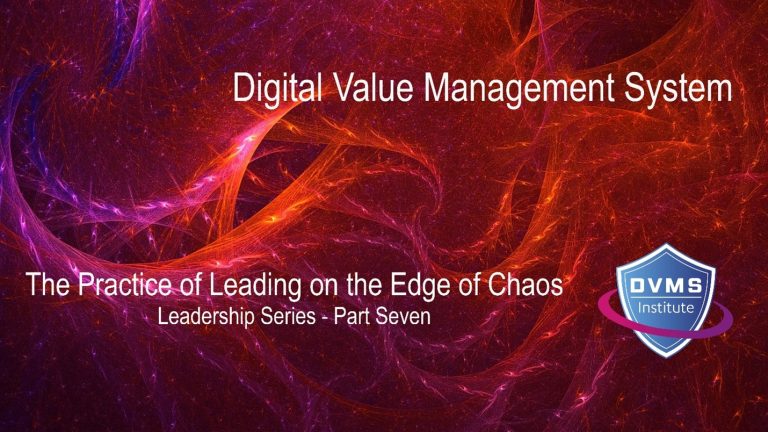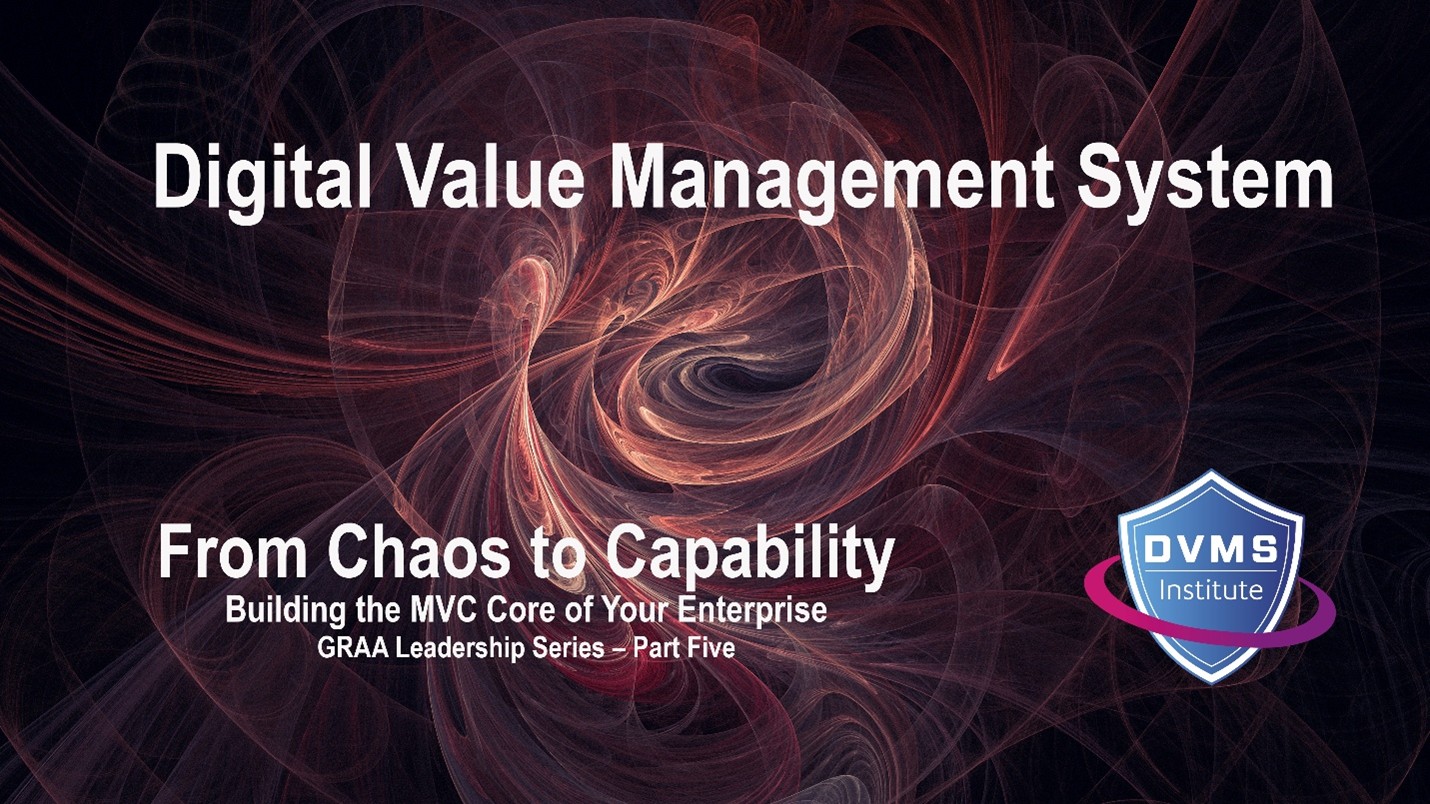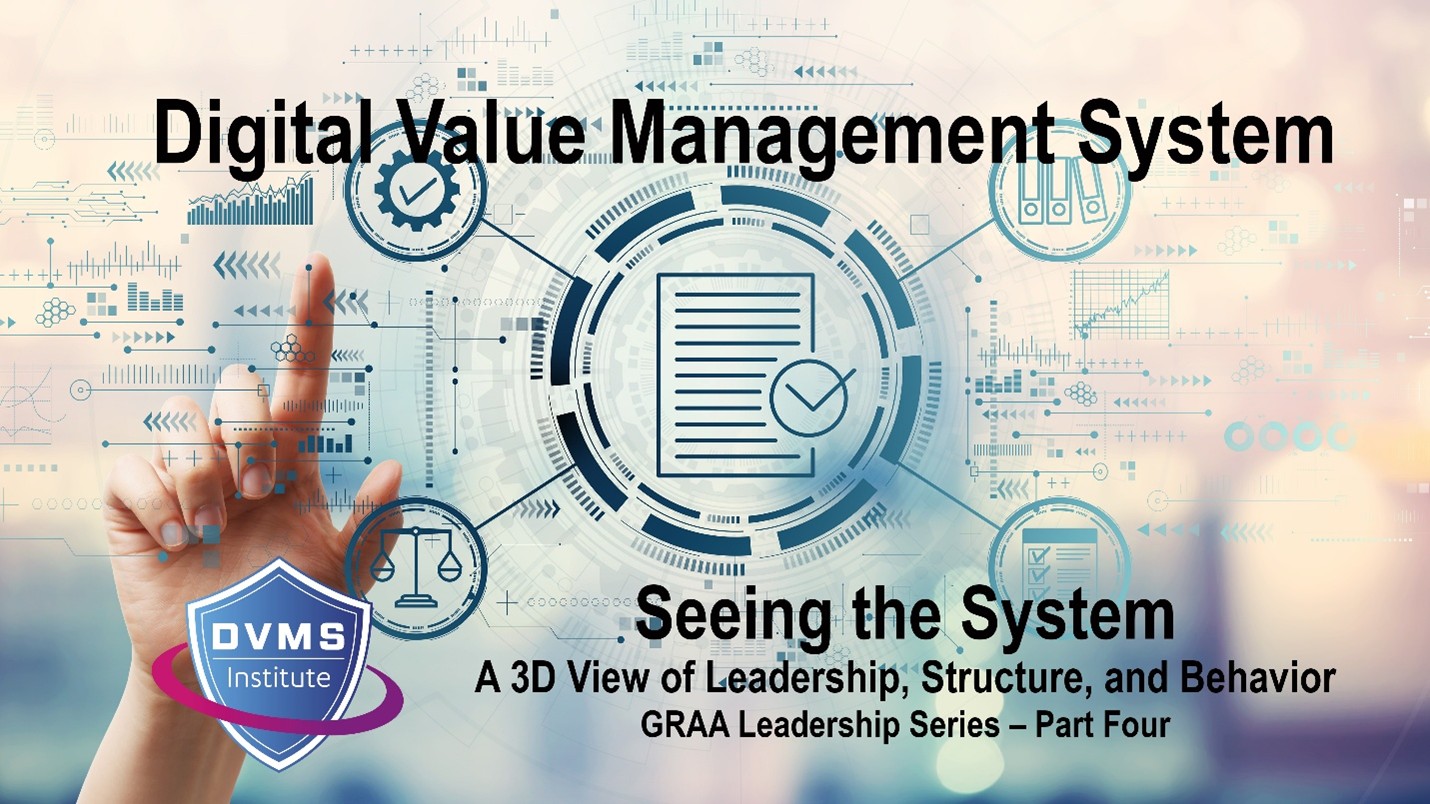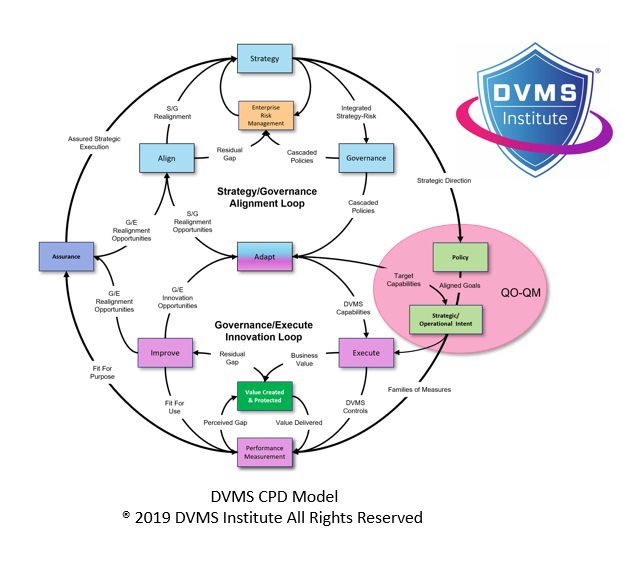From Adoption to Advantage – Integrating ITIL into the DVMS Approach
The Practice of Leading on the Edge of Chaos – A Leadership Call to Action – Part Seven
David Nichols – Co-Founder and Executive Director of the DVMS Institute
Introduction — From Theory to Application
In earlier installments of this series, we examined leadership principles in a digital age shaped by volatility and complexity. We discussed how leadership is no longer about command and control but orchestration: aligning culture, governance, and resilience at the “edge of chaos,” where adaptability meets stability. We introduced the 3D Knowledge Model to align leadership, structure, and behavior. We also reframed governance, resilience, and assurance as outcomes of leadership rather than isolated functions. We united these ideas in Part Six, demonstrating how executives must orchestrate value, risk, and culture.
But theory without practice is incomplete. Part Seven takes us beyond frameworks and concepts into the arena where leadership is tested most severely: in the crucible of transformation, mergers and acquisitions, supply chain resilience, and enterprise-wide resilience programs. These are the proving grounds of adaptive leadership. They reveal the difference between leaders who merely talk the language of resilience and those who truly embody it.
The Edge in Digital Transformation
Few phrases have been as overused and misunderstood as digital transformation. For many organizations, transformation is treated as a technology project. Leadership commissions a new platform, invests in new tools, or outsources modernization to consultants. Yet, despite billions of dollars spent, the results often disappoint. Studies consistently show that most digital transformations underperform or fail to deliver the expected value.
The problem isn’t technological; it’s cultural and leadership-related. For example, a global services company invested heavily in new cloud infrastructure. The technology was sound, but leadership didn’t align the cultural behaviors needed for success. Employees resisted adopting new workflows, middle managers clung to old processes, and the expected efficiencies never appeared. The transformation failed not because the platform was flawed but because leadership overlooked the importance of cultivating a culture that could embrace that change.
Contrast this with another organization that viewed digital transformation as a leadership journey rather than a technical upgrade. Here, the executive team dedicated as much time to defining the “why” as they did choosing the “what.” They applied the Create–Protect–Deliver (CPD) Model at the leadership level: developing a shared vision of future value, safeguarding through guardrails and risk framing, and delivering by aligning incentives and structures. They connected transformation directly to cultural values, innovation, transparency, accountability, and reinforced those values through visible actions. Adoption was not forced but nurtured. As a result, the transformation achieved both technological modernization and cultural resilience.
The lesson is clear. Digital transformation succeeds not when leaders focus solely on technology, but when they coordinate the balance of value, risk, and culture. Transformation is driven by leadership, not technology.
The Edge in Mergers and Acquisitions
Mergers and acquisitions are often seen as financial deals, but their real test is cultural. Numbers can show potential savings, but how well integration works depends on how leadership combines values, structures, and behaviors. The question isn’t just about alignment, it’s about integration. Alignment means coexisting; integration means creating something stronger, a whole greater than just the sum of its parts.
Imagine a manufacturing company that acquired a smaller, more innovative competitor. Instead of forcing uniformity or letting the acquired culture stay isolated, leadership approached the integration as a process of assimilation. They recognized that the smaller company’s innovative spirit was not a burden but a strength to be integrated into the larger organization. Assimilation, in this context, meant intentionally blending both cultures: maintaining independence where innovation flourished while aligning processes where scale and consistency were key.
Leadership accomplished this by framing the merger through the 3D Knowledge Model. On the Z-axis, they created a unifying narrative that respected the legacy of both companies while shaping a shared future. They selectively restructured workflows on the Y-axis, ensuring efficiency without hindering creativity. On the X-axis, they demonstrated respect and transparency, clearly stating that assimilation was about growth, not conquest.
The outcome was not a cultural compromise but cultural enrichment. Employees perceived their skills expanded, not reduced, and the organization became stronger than either company was on its own.
The lesson is that in M&A, cultural assimilation is the leader’s biggest opportunity. Financials may support a deal, but assimilation determines if value is truly created. Leaders who can guide assimilation—enhancing culture and capabilities rather than weakening them—turn mergers from mere calculations into drivers of resilience and innovation.
The Edge in Supply Chain Resilience
Supply chains have always been intricate, but recent years have shown how delicate they can be. The pandemic exposed how quickly a single disruption in one area can ripple through industries, halting production, emptying shelves, and testing resilience.
For some organizations, resilience was viewed as a matter of contracts and redundancy. A consumer goods company, for instance, believed that having multiple suppliers meant resilience. Leadership assigned risk management entirely to procurement teams, trusting assurances over evidence. When the disruption occurred, they found that several “backup” suppliers shared the same vulnerabilities. Governance was unclear, cultural behaviors discouraged escalation, and it was too late by the time issues became visible. Customers were lost, reputation suffered, and recovery was slow.
The DVMS approach redefines supply chain resilience as knowledge-based containment. The key question shifts from “Do we have suppliers?” to “Can our suppliers provide evidence that they can meet our needs under stress?” Containment requires verifiable proof, documented capabilities, tested recovery plans, and measurable performance, not just promises. Acknowledging performance gaps is not acceptable because those gaps will become evident when pressure is highest.
One company in the same industry adopted this approach. Its leadership required that suppliers show clear proof of resilience: audited processes, independent assurance reports, and real-time performance dashboards. They established transparency as a cultural norm and rewarded managers who raised concerns early. By viewing suppliers as partners in evidence-based resilience rather than just vendors with contracts, they built a network capable of absorbing disruptions. When a geopolitical event impacted their industry, issues emerged quickly, responses were coordinated, and the company stabilized operations and gained market share from competitors who lacked effective containment.
The difference is leadership’s willingness to demand proof, not promises. Supply chain resilience isn’t about blindly trusting suppliers; it’s about managing risk through tangible evidence of capability. Leaders who take this approach build supply chains that are efficient and resilient at the edge of chaos.
The Edge in Enterprise Resilience Programs
Enterprise resilience is no longer just an optional checkpoint; the core stance distinguishes organizations that survive from those that break apart. Many resilience efforts fail because they are seen as mere compliance tasks. However, the accurate measure of resilience isn’t a test; it’s the crisis itself.
Consider the 2024 ransomware attack on Change Healthcare, a UnitedHealth Group data-clearing subsidiary. What began as a compromised Citrix credential, exploited due to the lack of multi-factor authentication, quickly escalated into the largest healthcare data breach in U.S. history, exposing the personal and medical data of about 190 million Americans. Federal disclosures later increased that number to 192.7 million. The aftermath was immediate and severe: nationwide disruption of claims processing, enormous financial costs exceeding $3 billion, regulatory scrutiny, legal consequences, and a significant loss of trust in Wall Street.
Yet the breach revealed what happens when leaders prioritize resilience over strict compliance. UnitedHealth responded with proactive steps: disconnecting systems to contain the breach, hiring Mandiant for investigation and cybersecurity reinforcement, informing affected individuals, providing identity-protection support, and even deploying $6 billion in advance payments to stabilize hospital payments and reduce systemic disruption. The resilience that emerged was not accidental— it was deliberate.
This breach illustrates how the leadership role of Protect shifts from abstract policy to real-time action. The absence of culture-aligned structures, such as multi-factor authentication, opened the door to chaos, while leadership intent—reinforced through decisive systemic responses—helped restore resilience during the crisis.
Patterns of Success and Failure
A clear pattern appears throughout transformation, acquisitions, supply chain resilience, and enterprise-wide initiatives. Success depends not on technical skills or financial models but leadership’s ability to align and integrate efforts. Leaders who effectively balance Create–Protect–Deliver at the strategic level consistently outperform those who see it as an operational task.
Assimilation, in particular, becomes a crucial factor in mergers and acquisitions. Alignment can help cultures coexist, but assimilation enables capabilities and behaviors to merge into something more powerful. When leaders embrace assimilation, they create cultural enrichment, strengthening rather than weakening the organization. Conversely, when leaders enforce uniformity or accept fragmentation, value diminishes.
The same pattern applies elsewhere. In digital transformation, assimilation involves blending new technologies with existing cultural strengths so that innovation develops naturally rather than feeling forced. Supply chain resilience entails integrating transparency and trust into every part of the network to prevent disruptions from revealing weaknesses. In enterprise resilience programs, it means embedding resilience into daily routines instead of adding it as an afterthought.
Failure, by contrast, follows predictable patterns. When the Z-axis narrative of leadership conflicts with the Y-axis structures, dissonance occurs. When the X-axis behaviors oppose leadership rhetoric, trust erodes. The organization falls apart when governance, resilience, and assurance are assigned as isolated functions rather than integrated into the core of leadership intent.
The lessons are clear. Success belongs to leaders who view orchestration not as management, but as integration—an act of strengthening culture and capability to create a more resilient whole.
Practical Tools for Executives
Leaders can implement practical tools to embed these lessons. One such tool is the Z-axis audit introduced in Part Six. Periodically, executives should step back and ask: Is our leadership narrative aligned with our structures and behaviors? Are we managing value, risk, and culture in harmony, or are we allowing dissonance to persist?
Another way to use the CPD Model is as a leadership practice, not just an operational framework. When facing any major initiative—such as transformation, acquisition, supply chain challenge, or resilience program—leaders should ask: What are we creating? What are we protecting? How are we delivering? Asking these three questions consistently helps turn complexity into clarity.
Above all, leaders should remember that orchestration is an ongoing discipline, not a one-time act. The edge of chaos is not a place to visit only occasionally; it is where leadership now resides.
Expanding and Thriving on the Edge of Chaos
Part Seven has focused on practice. It demonstrated how the principles of orchestration unfold in high-stakes areas like transformation, mergers, supply chains, and resilience. It highlighted successes and failures, emphasizing that leadership on the edge is not just theory but a lived experience.
As we look ahead to Part Eight, we will push the boundaries further into the future. We will examine the challenges leaders face in navigating new frontiers: the governance of artificial intelligence, the ethical demands of digital society, and the shifting expectations of stakeholders in a world where trust is increasingly fragile.
Part Seven reminds us that leadership isn’t proven in carefully polished boardroom presentations but in the messy, complex, and unpredictable realities of practice. It is at the edge of chaos where leaders either falter or turn disruption into lasting advantage — and where the orchestration of value, risk, and culture becomes the defining measure of resilience.
About the Author

Dave is the Executive Director of the DVMS Institute.
Dave spent his “formative years” on US Navy submarines. There, he learned complex systems, functioning in high-performance teams, and what it takes to be an exceptional leader. He took those skills into civilian life and built a successful career leading high-performance teams in software development and information service delivery.
Traditional best-practice approaches to IT Service Management (ITSM), Governance, Risk and Compliance (GRC), and Cybersecurity are insufficient to manage the resilience, compliance, and trust requirements of today’s complex digital ecosystems.
The DVMS Cyber Resilience Professional Certified Training programs teach Organizations the skills to evolve any best-practice program into an integrated, adaptive, and culture-driven Digital Value Management Governance and Assurance System® (DVMS) that ensures resilient digital business operations.
For ITSM
The DVMS elevates ITSM from a process-aligned service-delivery program into an integrated, adaptive, and culture-driven governance and assurance overlay system, ensuring the delivery of high-performance and resilient digital business outcomes.
For GRC
The DVMS elevates GRC from a compliance checklist activity to an integrated, adaptive, and culture-driven governance and assurance overlay system, ensuring the resilient, compliant, and trusted digital business outcomes regulators expect.
For Cybersecurity
The DVMS elevates any cybersecurity program (NISTCSF, ISO, etc.) from a control-centric defense program into an integrated, adaptive, and culture-driven governance and assurance overlay system, transforming systemic cyber risk into compliant and trusted operational resilience.
By adopting a DVMS, organizations are positioned to:
- Maintain Operational Stability Amidst Constant Digital Disruption
- Deliver Digital Value and Trust Across A Digital Ecosystem
- Satisfy Critical Regulatory and Certification Requirements
- Leverage Cyber Resilience as a Competitive Advantage
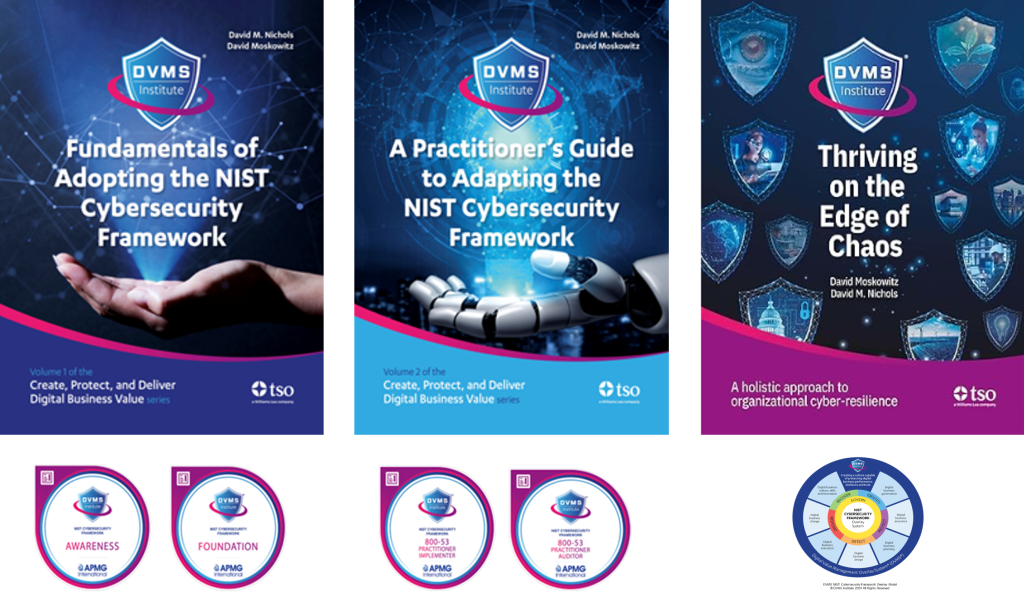
DVMS Explainer Videos
- Architecture Video: David Moskowitz explains the DVMS System
- Case Study Video: Dr. Joseph Baugh Shares His DVMS Story.
- Overlay Model – What is an Overlay Model
- MVC ZX Model – Powers the CPD
- CPD Model – Powers DVMS Operations
- 3D Knowledge Model – Powers the DVMS Culture
- FastTrack Model – Enables A Phased DVMS Adoption
Digital Value Management System® is a registered trademark of the DVMS Institute LLC.
® DVMS Institute 2025 All Rights Reserved

